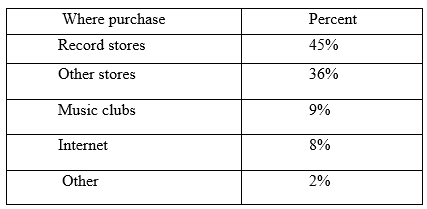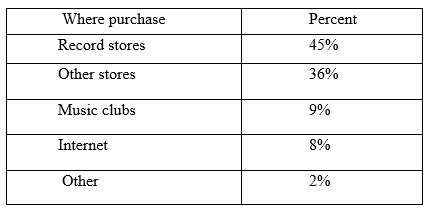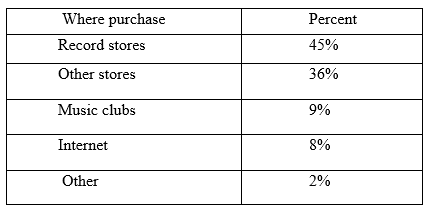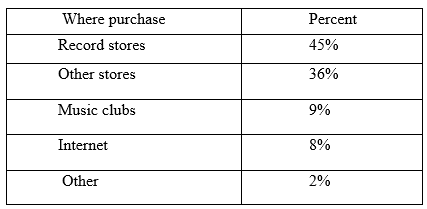
Concept explainers
a.
The number of students who chose either record stores or other stores.
a.
Answer to Problem 57E
The number of students that purchase from either record stores or other stores is
Explanation of Solution
Given:
The given table shows the results of a class survey that asked students where they make most of their music purchases.

Calculation:
As per the given problem
Consider the given table

Total number of students surveyed =
Percent of students that purchase from record stores =
Percent of students that purchase from other stores =
Number of students that purchase from record stores = percent of students that purchase from record stores
Similarly, Number of students that purchase from other stores=percent of students that purchase from other stores
Therefore,
Total number of students that purchase from either record stores or other stores
Conclusion:
The number of students that purchase from either record stores or other stores is
b.
To estimate how many more students chose record stores than music clubs
b.
Answer to Problem 57E
Explanation of Solution
Given:
The given table:

Total number of students surveyed =
Number of students that purchase from record stores =
Calculation:
As per the given problem
Total number of students surveyed =
Number of students that purchase from record stores =
Percent of students that purchase from music clubs =
Number of students that purchase from record stores = percent of students that purchase from music clubs
Difference between the number of students that purchase from record stores and that from music clubs =
Conclusion:
c.
To estimate how many students in both the surveys combined make most of their purchase from internet.
c.
Answer to Problem 57E
Explanation of Solution
Given:
The given table:

Total number of students in the first survey =
Percent of students that purchase from the internet in the first survey =
Number of students surveyed in the second time =
Percent of students that purchase from the internet in the second survey =
Calculation:
As per the given problem
Total number of students in the first survey =
Percent of students that purchase from the internet in the first survey =
Number of students surveyed in the second time =
Percent of students that purchase from the internet in the second survey =
Number of students that purchase from the internetin the first survey = percent of students that purchase from internet
Number of students that purchase from the internet in the secondsurvey = percent of students that purchase from internet
Therefore,
Total number of students in both the surveys combined make most of their purchase from internet
Conclusion:
Chapter 7 Solutions
EBK PRE-ALGEBRA
Additional Math Textbook Solutions
Elementary Statistics (13th Edition)
Elementary Statistics: Picturing the World (7th Edition)
A Problem Solving Approach To Mathematics For Elementary School Teachers (13th Edition)
University Calculus: Early Transcendentals (4th Edition)
A First Course in Probability (10th Edition)
- Solutions of inequalitie Google Classroom Mic Is (-3, 2) a solution of 7x+9y > -3? Choose 1 answer: A Yes B No Related content ▶6:06 Testing solutions to inequalities 2 of 4arrow_forwardAre natural logarithms used in real life ? How ? Can u give me two or three ways we can use them. Thanksarrow_forward?arrow_forward
- Solve the equation. Write the smaller answer first. 2 (x-6)² = 36 x = Α x = Previous Page Next Pagearrow_forwardWrite a quadratic equation in factored form that has solutions of x = 2 and x = = -3/5 ○ a) (x-2)(5x + 3) = 0 ○ b) (x + 2)(3x-5) = 0 O c) (x + 2)(5x -3) = 0 ○ d) (x-2)(3x + 5) = 0arrow_forwardA vacant lot is being converted into a community garden. The garden and a walkway around its perimeter have an area of 690 square feet. Find the width of the walkway (x) if the garden measures 14 feet wide by 18 feet long. Write answer to 2 decimal places. (Write the number without units). Hint: add 2x to each of the garden dimensions of 14 x 18 feet to get the total area for the length multiplied by width.arrow_forward
- Solve the rational equation 14 1 + x-6 x x-7 x-7 ○ a) x = 1, x = 8 ○ b) x = 1 ○ c) x = 7 ○ d) x = 1, x = 7arrow_forwardSolve the absolute inequality | x + 5 > 3 ○ a) (-∞, -8] U[-2, ∞0) ☐ b) (-8, -2) c) (-2, ∞0) ○ d) (-∞, - 8) U(-2, ∞0)arrow_forward1) Listen Describe the error in the problem X 3 X x 3 - 2 = 25x = 0 25x 25 x = ±5arrow_forward
 Algebra and Trigonometry (6th Edition)AlgebraISBN:9780134463216Author:Robert F. BlitzerPublisher:PEARSON
Algebra and Trigonometry (6th Edition)AlgebraISBN:9780134463216Author:Robert F. BlitzerPublisher:PEARSON Contemporary Abstract AlgebraAlgebraISBN:9781305657960Author:Joseph GallianPublisher:Cengage Learning
Contemporary Abstract AlgebraAlgebraISBN:9781305657960Author:Joseph GallianPublisher:Cengage Learning Linear Algebra: A Modern IntroductionAlgebraISBN:9781285463247Author:David PoolePublisher:Cengage Learning
Linear Algebra: A Modern IntroductionAlgebraISBN:9781285463247Author:David PoolePublisher:Cengage Learning Algebra And Trigonometry (11th Edition)AlgebraISBN:9780135163078Author:Michael SullivanPublisher:PEARSON
Algebra And Trigonometry (11th Edition)AlgebraISBN:9780135163078Author:Michael SullivanPublisher:PEARSON Introduction to Linear Algebra, Fifth EditionAlgebraISBN:9780980232776Author:Gilbert StrangPublisher:Wellesley-Cambridge Press
Introduction to Linear Algebra, Fifth EditionAlgebraISBN:9780980232776Author:Gilbert StrangPublisher:Wellesley-Cambridge Press College Algebra (Collegiate Math)AlgebraISBN:9780077836344Author:Julie Miller, Donna GerkenPublisher:McGraw-Hill Education
College Algebra (Collegiate Math)AlgebraISBN:9780077836344Author:Julie Miller, Donna GerkenPublisher:McGraw-Hill Education





